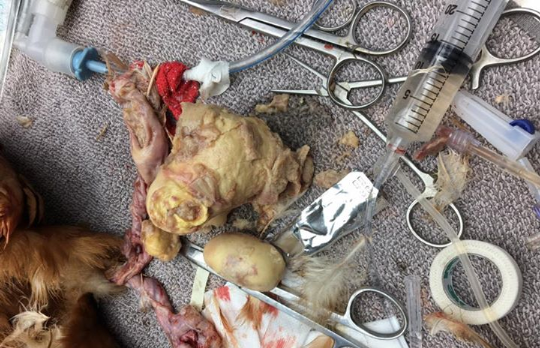
The day I met Anna, I was warned she didn’t have much longer to live. It was mid-winter and she walked toward me small and gaunt. Her caretaker asked me if I wanted to “feel it” and Anna silently watched as my hand traced the tumor filling her abdomen. I felt her thin frame stretched under the weight of this bulbous growth. It was a miracle she made it to spring. It was a miracle she made it to summer. When her legs finally gave out, she’d sit atop a big lawn chair, watching over the garden, and refuse to consume anything but fresh-squeezed orange juice. In her dying moments, we gathered around her on the bed and held her as she contorted in pain and finally succumbed to the cancer.
The cause of Anna’s cancer had one clear culprit. Anna was a survivor, and ultimately a victim, of the egg industry. Every year, millions of chickens like her slowly die of cancer caused by generations of intensive breeding that has pushed their bodies beyond their limits.
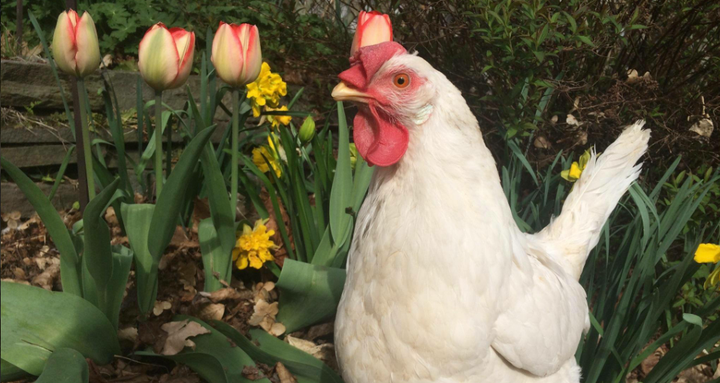
Anna was rescued from a California egg facility in 2013 and died of cancer at a sanctuary in New Jersey two years later.
For years, research has shown an association between consumption of chickens’ eggs and increased risk of prostate and colorectal cancer in humans. Yet, amid updated dietary guidelines and animal welfare campaigns for cage-free production methods, an epidemic goes unnoticed. Bred for countless generations to have a hyperactive reproductive system, chickens used for their eggs now have one of the highest known rates of ovarian cancer of any species.
The undomesticated ancestor of the modern chicken laid eggs for the same purpose as any other bird—reproduction—and in similar numbers at typically around a dozen a year. These eggs were frugally laid after the hen found a mate. The eggs then hatched into chicks, who the hen diligently raised.
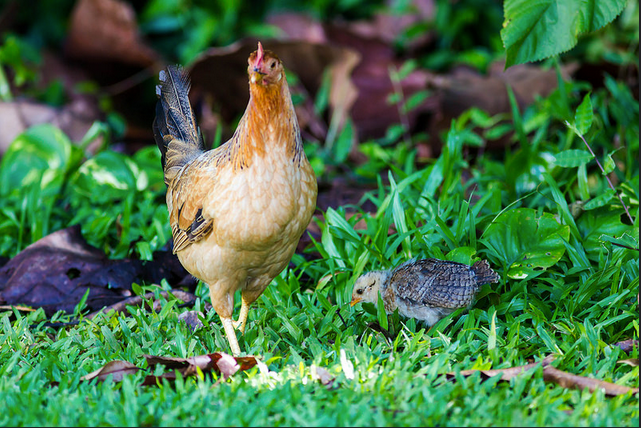
A Red Junglefowl mother is pictured with her chick.
Today, chickens used for eggs—from factory farms to backyard flocks—are the products of centuries of human control over their mating process. As a result of generations of selective breeding, these birds now produce on average over 300 eggs a year, more than twenty times their wild counterparts.
Regardless of species, the process of forming and laying an egg seems deceptively easy, but is actually incredibly arduous. Anecdotally, I’ve known several people who almost lost their parrots when the birds struggled to lay eggs. A friend’s snake died after a decade of companionship when she failed to push her first egg out.
For chickens, from start to finish, the process of forming and laying a single egg takes 23 to 27 hours. When we meddled with chickens’ reproductive systems, we took an infrequent but already grueling process and made it incessant. In doing so, we devastated their bodies.
Cancer
One health issue almost all of us have been touched by is cancer. Whether we’ve had it ourselves, supported a friend or family member through treatment, or gone through the heartbreaking process of providing chemo for a dog or cat we love, we all have a sense of just how tragic this disease can be.
Yet, through tampering with hens’ reproductive systems, we’ve literally bred cancer into their bodies. As one study states, “No other animal develops spontaneous OVC [Ovarian Cancer] tumors at comparable rates to the chicken, which can exceed 35%.” Read that again. Of chickens studied, in some cases over a third of a population spontaneously developed ovarian cancer without anything done medically to induce this. This phenomenon is so widely recognized that egg-breed hens are rapidly becoming a preferred model for research on human reproductive cancer.
Prolapses
Though cancer is the disease with which many of us are most familiar, it is but one among many reproductive conditions from which hens suffer. By pushing out egg after sizeable egg, their reproductive systems become exhausted and their vaginas and uteruses may begin to essentially fall out of their bodies in reproductive prolapses. The hen will then likely die of hemorrhage or shock. One study found prolapses killed 11 percent of an egg-laying population.
Calcium Deficiency
Another common issue is calcium deficiency. Birds have a medullary bone that stores calcium for eggshells. In hens, rapid egg production depletes this bone to the point of it disappearing. Hens then have to leech calcium from other parts of their bodies to continue forming hard shells. This causes them to develop osteoporosis and consequent bone fractures. They also develop hypocalcemia or calcium tetany (paralysis) from using all available calcium in their bloodstream for eggs. As in humans, having extremely low levels of calcium in the bloodstream causes chickens to develop more minor symptoms, like numbness and disorientation, and more major and fatal symptoms, like seizures and heart attacks. A recent study on causes of death on egg farms that are unrelated to disease spread found this condition is the second most common killer.
Impactions and Peritonitis
Other hens may continue laying despite calcium-depletion and exhaustion, but reach a point when they are unable to expel all egg material from their bodies. This can result in a build up of impacted egg material and consequent fatal peritonitis infection, the leading cause of death outside of disease spread.
Ultimately, the majority of domesticated hens will slowly suffer from these reproductive conditions, regardless of whether they’re in battery cages or suburban backyards. For those who value these birds strictly for their egg production, hens with unhealthy reproductive systems are considered worthless and it is standard practice to kill them at around two years of age.
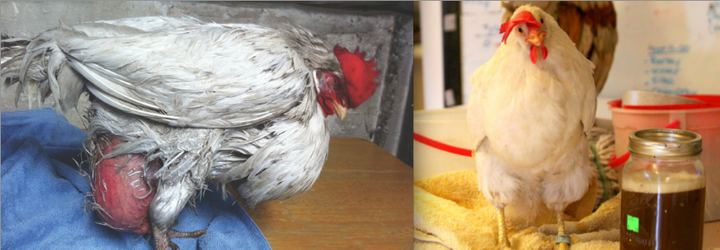
On the left: Sweet Pea was rescued by Free From Harm in Illinois, but died of Peritonitis, the mass seen here extending from her abdomen to the floor.
On the right: Seven was rescued by Hen Harbor in California. She is pictured here next to a jar filled with infected fluid that has been drained from her abdomen.
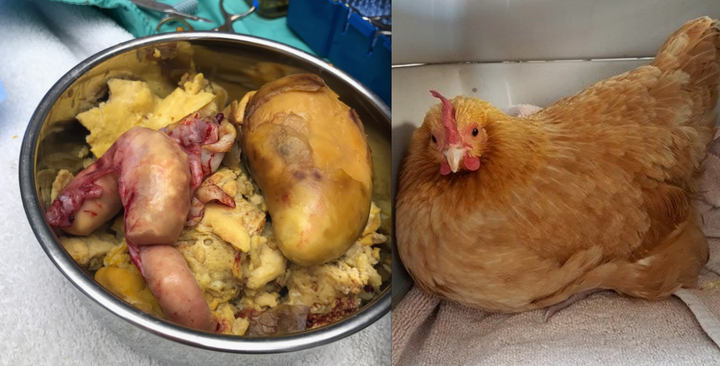
Doree was rescued by Triangle Chicken Advocates in North Carolina from the backyard flock of someone who claimed to love her. At barely over three pounds, half her body weight was impacted egg material. She died following surgery to remove the impaction.
When I meet new people, it’s not long before they learn I am passionate about chickens and that I rescue, care for, and advocate for them. They’re usually surprised to learn that many chickens love to spend time with humans (they’ll even cuddle in your lap if you let them). In my discussions, I share with them that animal behaviorists compare chicken intelligence to that of human toddlers and my own experience confirms this: I’ve not only taught chickens basic commands like “come,” but also successfully used time-outs to teach them good behavior.
At some point I share with my listeners what it is like to participate in a rescue—to pull birds from the clutches of imminent death and watch them blossom into full personalities eager to live—only to soon thereafter watch them begin to show the early symptoms of reproductive disease. I share what it is like to then see them get sicker and sicker, and then struggle to hang on to life, and finally to lose them to what is unmistakably a painful death.
I then ask these people (as I am asking you now): If we can spare innocent animals this torturous journey simply by not consuming their eggs, why wouldn’t we?
And this is the big question we must ask ourselves when we consider using animals in any form: If we can live happy, healthy lives without depriving others of their health or their family or their lives, what are we waiting for?
***
Author’s Note: There is a community of people who rescue chickens and fight against the health issues that have been bred into their bodies, working tirelessly to keep them alive. Today, fewer and fewer rescued hens are dying prematurely because fewer and fewer are laying eggs. Rescuers have discovered use of hormonal implant birth control can successfully shut down hens’ reproductive systems, stop them from laying eggs, and prevent all of the conditions discussed here. Keeping hens alive means halting their egg production.
